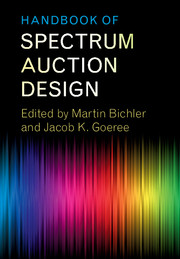Book contents
- Frontmatter
- Contents
- List of Contributors
- Preface
- List of Papers
- Part I The Simultaneous Multiple-Round Auction
- 1 Putting Auction Theory to Work: The Simultaneous Ascending Auction
- 2 An Equilibrium Analysis of the Simultaneous Ascending Auction
- 3 The Efficiency of the FCC Spectrum Auctions
- 4 Measuring the Efficiency of an FCC Spectrum Auction
- Part II The Combinatorial Clock Auction Designs
- Part III Alternative Auction Designs
- Part IV Experimental Comparisons of Auction Designs
- Part V The Bidders’ Perspective
- Part VI Secondary Markets and Exchanges
- Outlook
- References
1 - Putting Auction Theory to Work: The Simultaneous Ascending Auction
from Part I - The Simultaneous Multiple-Round Auction
Published online by Cambridge University Press: 26 October 2017
- Frontmatter
- Contents
- List of Contributors
- Preface
- List of Papers
- Part I The Simultaneous Multiple-Round Auction
- 1 Putting Auction Theory to Work: The Simultaneous Ascending Auction
- 2 An Equilibrium Analysis of the Simultaneous Ascending Auction
- 3 The Efficiency of the FCC Spectrum Auctions
- 4 Measuring the Efficiency of an FCC Spectrum Auction
- Part II The Combinatorial Clock Auction Designs
- Part III Alternative Auction Designs
- Part IV Experimental Comparisons of Auction Designs
- Part V The Bidders’ Perspective
- Part VI Secondary Markets and Exchanges
- Outlook
- References
Summary
Introduction
The “simultaneous ascending auction” was first introduced in 1994 to sell licenses to use bands of radio spectrum in the United States. Much of the attention devoted to the auction came from its role in reducing federal regulation of the radio spectrum and allowing market values, rather than administrative fiat, to determine who would use the spectrum resource. Many observers were also fascinated by the then-novel use of weblike interfaces for bidders. The large amounts of money involved were yet another source of interest. The very first use of the auction rules was a $617 million sale of 10 paging licenses in July 1994. In the broadband personal communications services (PCS) auction, which began in December 1994, 99 licenses were sold for a total price of approximately $7 billion. Once the auctions had been conducted, it became much harder to ignore the tremendous value of the large amounts of spectrum allocated to uses such as high-definition television, for which Congress had demanded no compensation at all. Moreover, the perceived successes with the new rules inspired imitators to conduct similar spectrum auctions in various countries around the world and to recommend similar auctions for other applications.
Among academic economists, attention was also piqued because the auction design made detailed use of the ideas of economic theory and the recommendations of economic theorists. Indeed, the U.S. communications regulator adopted nearly all its important rules from two detailed proposals for a simultaneous ascending auction: one by Preston McAfee and the other by Robert Wilson and me. Economic analysis dictated nearly all the rule choices in the first few auctions. Various reviews suggest that the new auction design realized at least some of the theoretical advantages that had been claimed for it.
Several parts of economic theory proved helpful in designing the rules for the simultaneous ascending auction and in thinking about how the design might be improved and adapted for new applications. After briefly reviewing the major rules of the auction in Section II, I turn in Section III to an analysis based on tatonnement theory, which regards the auction as a mechanism for discovering an efficient allocation and its supporting prices. The analysis reveals a fundamental difference between situations in which the licenses are mutual substitutes and others in which the same licenses are sometimes substitutes and sometimes complements.
- Type
- Chapter
- Information
- Handbook of Spectrum Auction Design , pp. 3 - 25Publisher: Cambridge University PressPrint publication year: 2017



